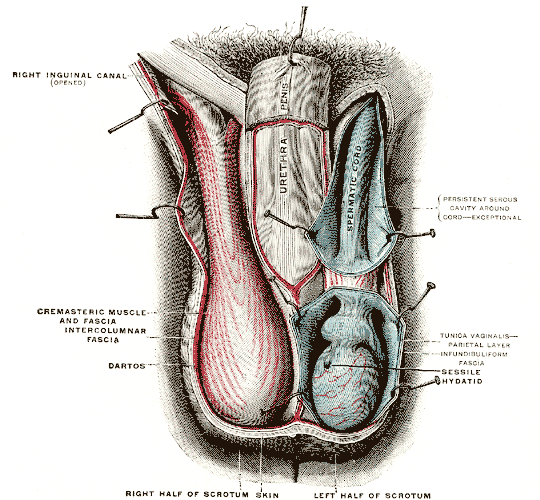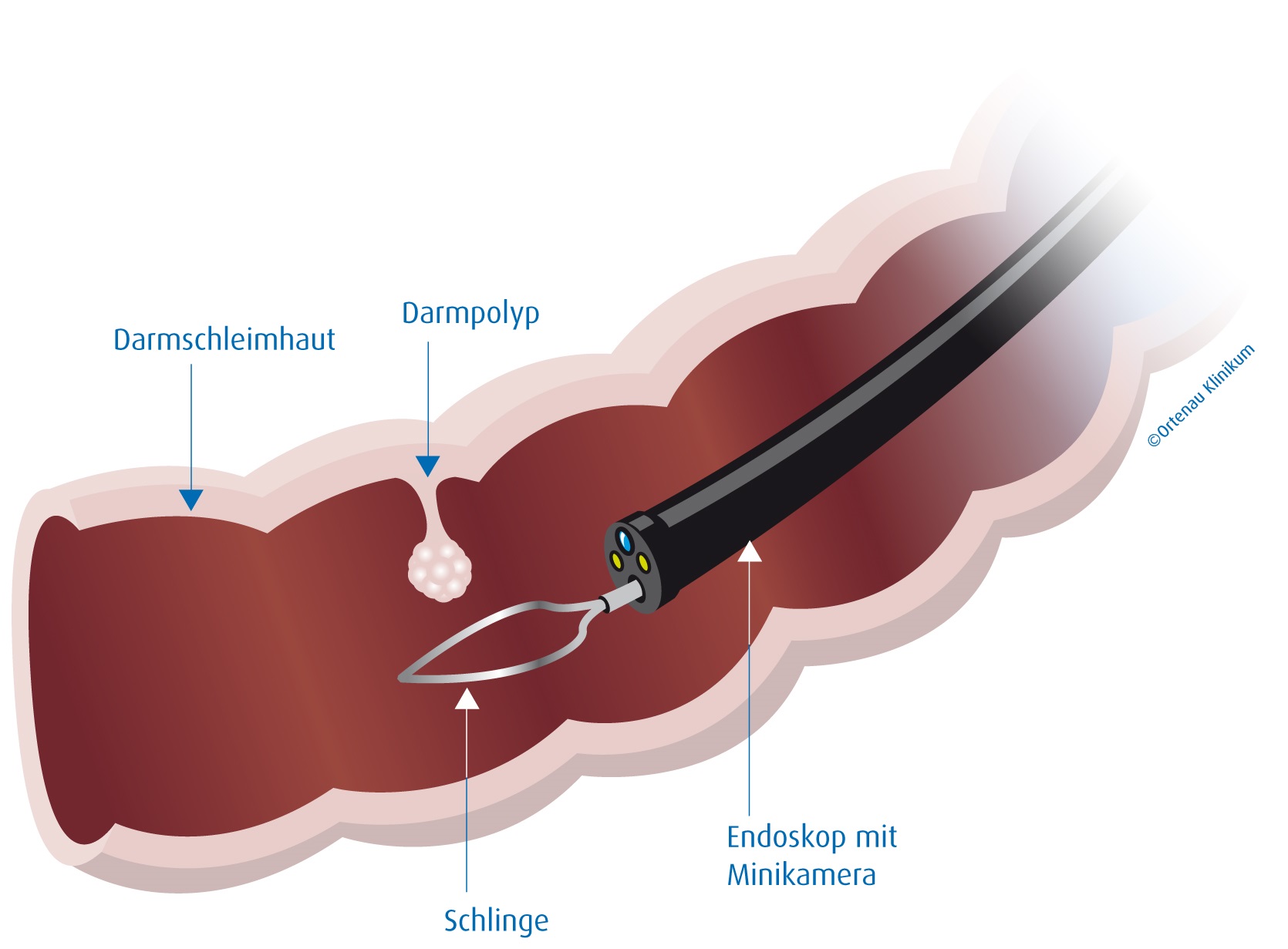|
Pneumoscrotum
Pneumoscrotum is an uncommon ailment that presents as an enlarged scrotal sac. The buildup of gas or air in the scrotum causes the swelling. Pneumoscrotum refers to two specific conditions: scrotal pneumatocele and scrotal emphysema with palpable crepitus. Pneumoscrotum can arise from a variety of sources, including infections and the dispersal of gas or air from far-off organs or areas. Causes Pneumoscrotum is most commonly caused by iatrogenic factors (colonic perforation following endoscopic polypectomy) and traumatic factors (thoracic trauma). Additionally, spontaneous causes of pneumoscrotum include gas-producing bacterial infections, spontaneous pneumothorax, and perforation of hollow abdominal organs. Mechanism There are three possible physiopathological explanations for pneumoscrotum. One is that the infection may be brought on by bacteria that produce gas, which allows air to enter the scrotum directly or diffuse through subcutaneous tissues (such as FG). The existence of ... [...More Info...] [...Related Items...] OR: [Wikipedia] [Google] [Baidu] |
Scrotal Inflation
Scrotal inflation, or scrotal infusion, is a sexual practice in which fluid (typically saline (medicine), saline solution, but sometimes air or another gas) is injected into the scrotum in order to make it balloon in size. It carries a number of risks of serious complications, including scrotal cellulitis and subcutaneous emphysema, and possibly fatal complications such as Fournier's gangrene or air embolism. See also * Cock and ball torture * Medical fetish * Hydrocele * Pneumoscrotum References BDSM terminology Sexual acts Scrotum {{sex-stub ... [...More Info...] [...Related Items...] OR: [Wikipedia] [Google] [Baidu] |
Urology
Urology (from Greek οὖρον ''ouron'' "urine" and '' -logia'' "study of"), also known as genitourinary surgery, is the branch of medicine that focuses on surgical and medical diseases of the urinary-tract system and the reproductive organs. Organs under the domain of urology include the kidneys, adrenal glands, ureters, urinary bladder, urethra, and the male reproductive organs ( testes, epididymis, vas deferens, seminal vesicles, prostate, and penis). The urinary and reproductive tracts are closely linked, and disorders of one often affect the other. Thus a major spectrum of the conditions managed in urology exists under the domain of genitourinary disorders. Urology combines the management of medical (i.e., non-surgical) conditions, such as urinary-tract infections and benign prostatic hyperplasia, with the management of surgical conditions such as bladder or prostate cancer, kidney stones, congenital abnormalities, traumatic injury, and stress incontinence ... [...More Info...] [...Related Items...] OR: [Wikipedia] [Google] [Baidu] |
Scrotum
The scrotum or scrotal sac is an anatomical male reproductive structure located at the base of the penis that consists of a suspended dual-chambered sac of skin and smooth muscle. It is present in most terrestrial male mammals. The scrotum contains the external spermatic fascia, testes, epididymis, and ductus deferens. It is a distention of the perineum and carries some abdominal tissues into its cavity including the testicular artery, testicular vein, and pampiniform plexus. The perineal raphe is a small, vertical, slightly raised ridge of scrotal skin under which is found the scrotal septum. It appears as a thin longitudinal line that runs front to back over the entire scrotum. In humans and some other mammals the scrotum becomes covered with pubic hair at puberty. The scrotum will usually tighten during penile erection and when exposed to cold temperatures. One testis is typically lower than the other to avoid compression in the event of an impact. The scrotum is bio ... [...More Info...] [...Related Items...] OR: [Wikipedia] [Google] [Baidu] |
Pneumatocele
A pneumatocele is a cavity in the lung parenchyma filled with air that may result from pulmonary trauma during mechanical ventilation. Gas-filled, or air-filled lesions in bone are known as pneumocysts. When a pneumocyst is found in a bone it is called an intraosseous pneumocyst, or a vertebral pneumocyst when found in a vertebra. Cause A pneumatocele results when a lung laceration, a cut or tear in the lung tissue, fills with air. A rupture of a small airway creates the air-filled cavity. Pulmonary lacerations that fill with blood are called pulmonary hematomas. In some cases, both pneumatoceles and hematomas exist in the same injured lung. A pneumatocele can become enlarged, for example when the patient is mechanically ventilated or has acute respiratory distress syndrome, in which case it may not go away for months. Intraosseous pneumatocysts in the bone are rare and of unclear origin. They are benign and usually without symptoms. They are also found around a sacroiliac j ... [...More Info...] [...Related Items...] OR: [Wikipedia] [Google] [Baidu] |
Emphysema
Emphysema, or pulmonary emphysema, is a lower respiratory tract disease, characterised by air-filled spaces ( pneumatoses) in the lungs, that can vary in size and may be very large. The spaces are caused by the breakdown of the walls of the alveoli and they replace the spongy lung parenchyma. This reduces the total alveolar surface available for gas exchange leading to a reduction in oxygen supply for the blood. Emphysema usually affects the middle aged or older population because it takes time to develop with the effects of tobacco smoking, and other risk factors. Alpha-1 antitrypsin deficiency is a genetic risk factor that may lead to the condition presenting earlier. When associated with significant airflow limitation, emphysema is a major subtype of chronic obstructive pulmonary disease ( COPD), a progressive lung disease characterized by long-term breathing problems and poor airflow. Without COPD, the finding of emphysema on a CT lung scan still confers a higher m ... [...More Info...] [...Related Items...] OR: [Wikipedia] [Google] [Baidu] |
Crepitus
Crepitus is "a grating sound or sensation produced by friction between bone and cartilage or the fractured parts of a bone". Various types of crepitus that can be heard in joint pathologies are: *Bone crepitus: This can be heard when two fragments of a fracture are moved against each other. *Joint crepitus: This can be obtained when the affected joint is passively moved with one hand, while the other hand is placed on the joint to feel the crepitus. *Crepitus of bursitis: This is heard when the fluid in the bursa contains small, loose fibrinous particles. *Crepitus of tenosynovitis: From inflammation of the fluid-filled sheath (synovium) that surrounds a tendon. Causes The sound can be created when two rough surfaces in an organism's body come into contact—for example, in osteoarthritis or rheumatoid arthritis when the cartilage around joints erodes and the surfaces in the joint grind against one another, or when the two fractured surfaces of the broken bones rub together. ... [...More Info...] [...Related Items...] OR: [Wikipedia] [Google] [Baidu] |
Iatrogenesis
Iatrogenesis is the causation of a disease, a harmful complication, or other ill effect by any medical activity, including diagnosis, intervention, error, or negligence. "Iatrogenic", ''Merriam-Webster.com'', Merriam-Webster, Inc., accessed 27 Jun 2020. First used in this sense in 1924, the term was introduced to sociology in 1976 by Ivan Illich, alleging that industrialized societies impair quality of life by overmedicalizing life."iatrogenesis" ''A Dictionary of Sociology'', . updated 31 May 2020. Iatrogenesis may thus include mental suffering via medical beliefs or a practitioner's statements. Some iatrogen ... [...More Info...] [...Related Items...] OR: [Wikipedia] [Google] [Baidu] |
Polypectomy
In medicine, a polypectomy is the removal of an abnormal growth of tissue called a polyp. Polypectomy can be performed by excision if the polyp is external (on the skin). See also * Colonic polypectomy Colonic polypectomy is the removal of colorectal polyps in order to prevent them from turning cancerous. Gastrointestinal polyps can be removed endoscopically through colonoscopy or esophagogastroduodenoscopy, or surgically if the polyp is too ... * Non-lifting sign References {{surgery-stub Surgical procedures and techniques ... [...More Info...] [...Related Items...] OR: [Wikipedia] [Google] [Baidu] |
Pneumothorax
A pneumothorax is an abnormal collection of air in the pleural space between the lung and the chest wall. Symptoms typically include sudden onset of sharp, one-sided chest pain and shortness of breath. In a minority of cases, a one-way valve is formed by an area of damaged tissue, and the amount of air in the space between chest wall and lungs increases; this is called a tension pneumothorax. This can cause a steadily worsening oxygen shortage and low blood pressure. This leads to a type of shock called obstructive shock, which can be fatal unless reversed. Very rarely, both lungs may be affected by a pneumothorax. It is often called a "collapsed lung", although that term may also refer to atelectasis. A primary spontaneous pneumothorax is one that occurs without an apparent cause and in the absence of significant lung disease. A secondary spontaneous pneumothorax occurs in the presence of existing lung disease. Smoking increases the risk of primary spontaneous pneumot ... [...More Info...] [...Related Items...] OR: [Wikipedia] [Google] [Baidu] |
Abdominal Cavity
The abdominal cavity is a large body cavity in humans and many other animals that contains many organs. It is a part of the abdominopelvic cavity. It is located below the thoracic cavity, and above the pelvic cavity. Its dome-shaped roof is the thoracic diaphragm, a thin sheet of muscle under the lungs, and its floor is the pelvic inlet, opening into the pelvis. Structure Organs Organs of the abdominal cavity include the stomach, liver, gallbladder, spleen, pancreas, small intestine, kidneys, large intestine, and adrenal glands. Peritoneum The abdominal cavity is lined with a protective membrane termed the peritoneum. The inside wall is covered by the parietal peritoneum. The kidneys are located behind the peritoneum, in the retroperitoneum, outside the abdominal cavity. The viscera are also covered by visceral peritoneum. Between the visceral and parietal peritoneum is the peritoneal cavity, which is a potential space. It contains a serous fluid called periton ... [...More Info...] [...Related Items...] OR: [Wikipedia] [Google] [Baidu] |
CT Scan
A computed tomography scan (CT scan; formerly called computed axial tomography scan or CAT scan) is a medical imaging technique used to obtain detailed internal images of the body. The personnel that perform CT scans are called radiographers or radiology technologists. CT scanners use a rotating X-ray tube and a row of detectors placed in a gantry to measure X-ray attenuations by different tissues inside the body. The multiple X-ray measurements taken from different angles are then processed on a computer using tomographic reconstruction algorithms to produce tomographic (cross-sectional) images (virtual "slices") of a body. CT scans can be used in patients with metallic implants or pacemakers, for whom magnetic resonance imaging (MRI) is contraindicated. Since its development in the 1970s, CT scanning has proven to be a versatile imaging technique. While CT is most prominently used in medical diagnosis, it can also be used to form images of non-living objects. The 1979 N ... [...More Info...] [...Related Items...] OR: [Wikipedia] [Google] [Baidu] |






